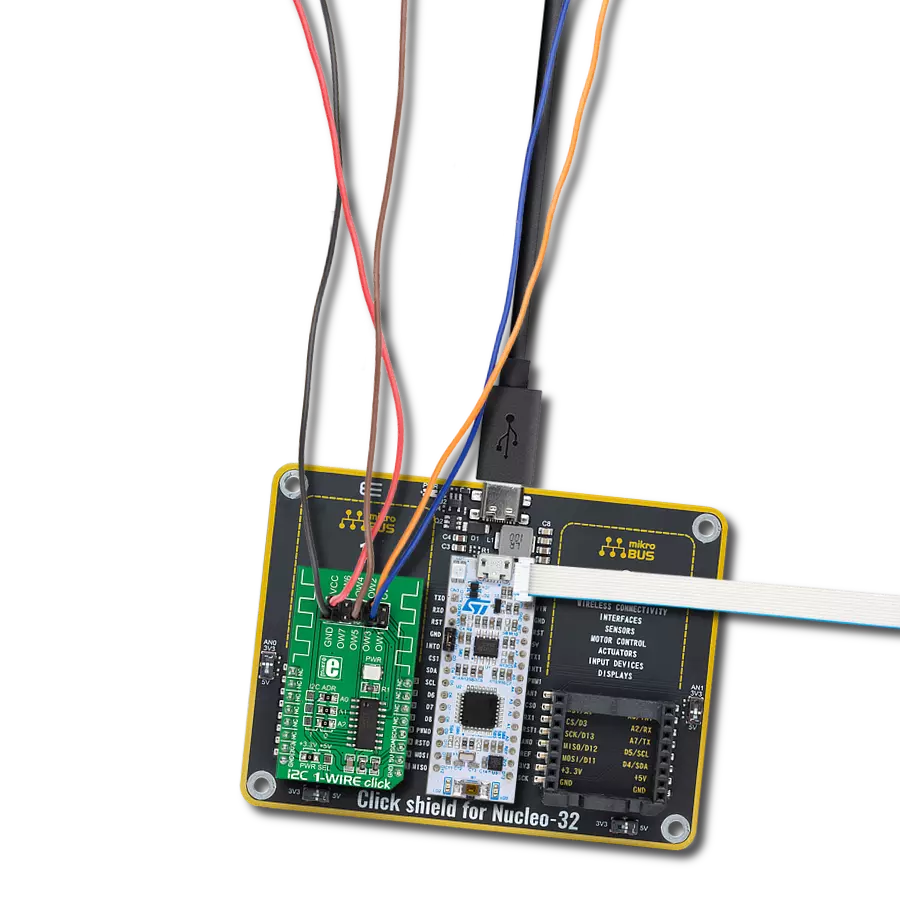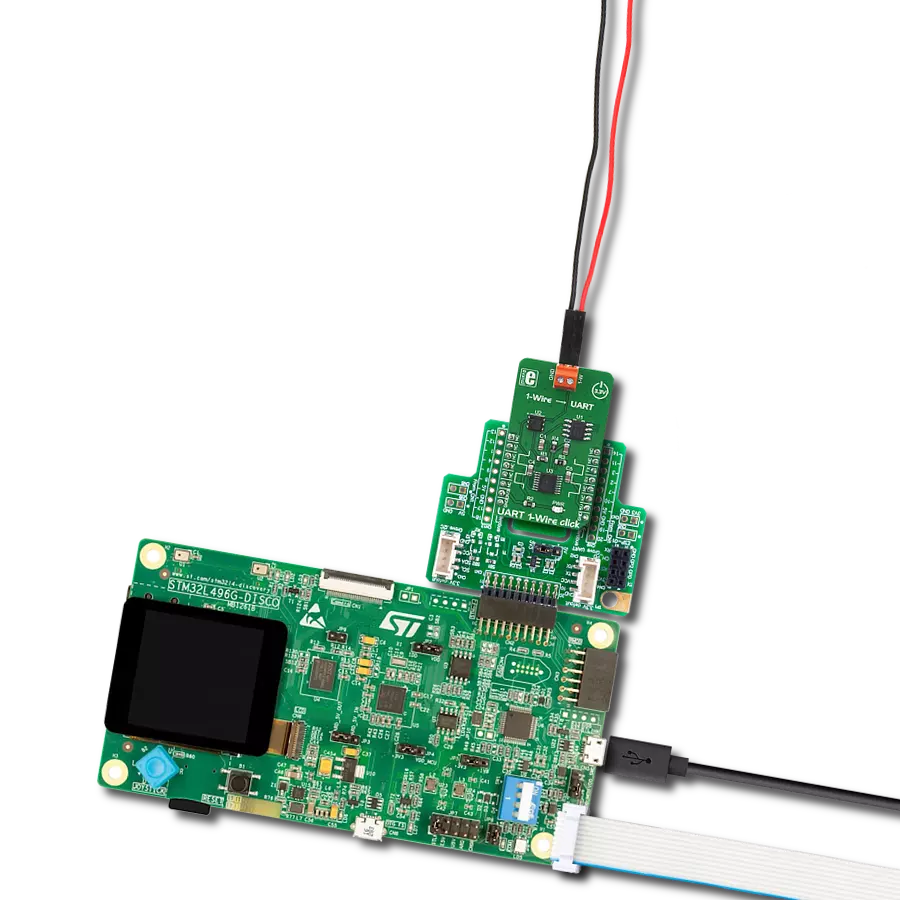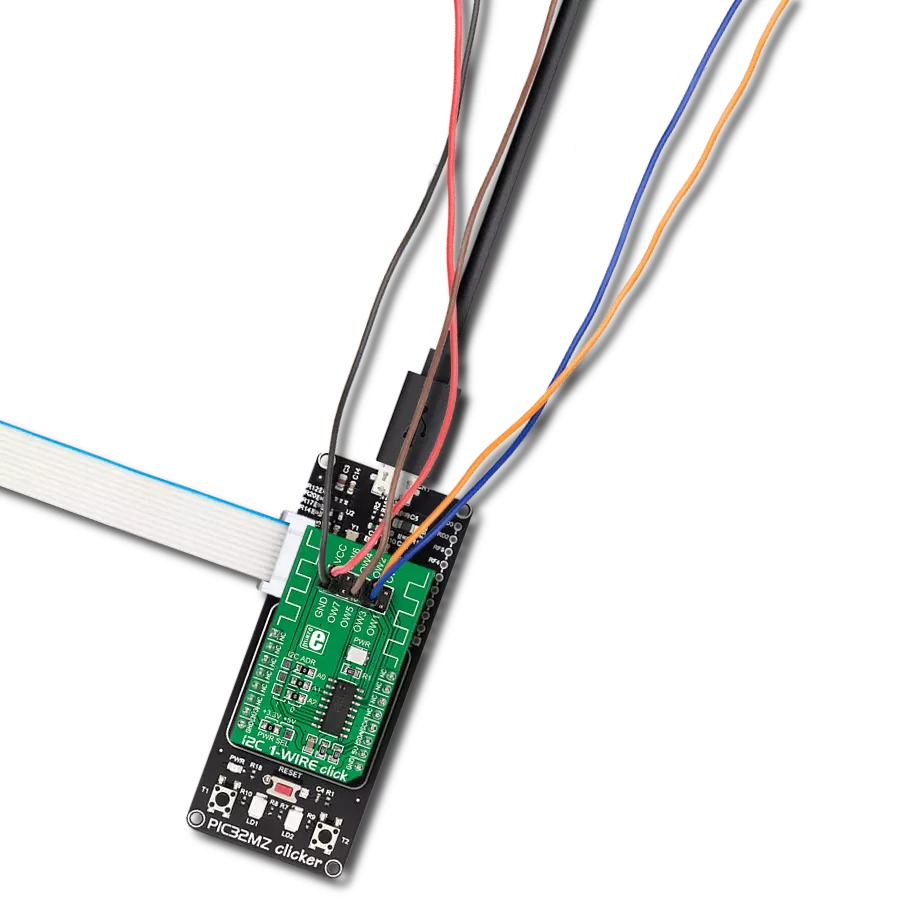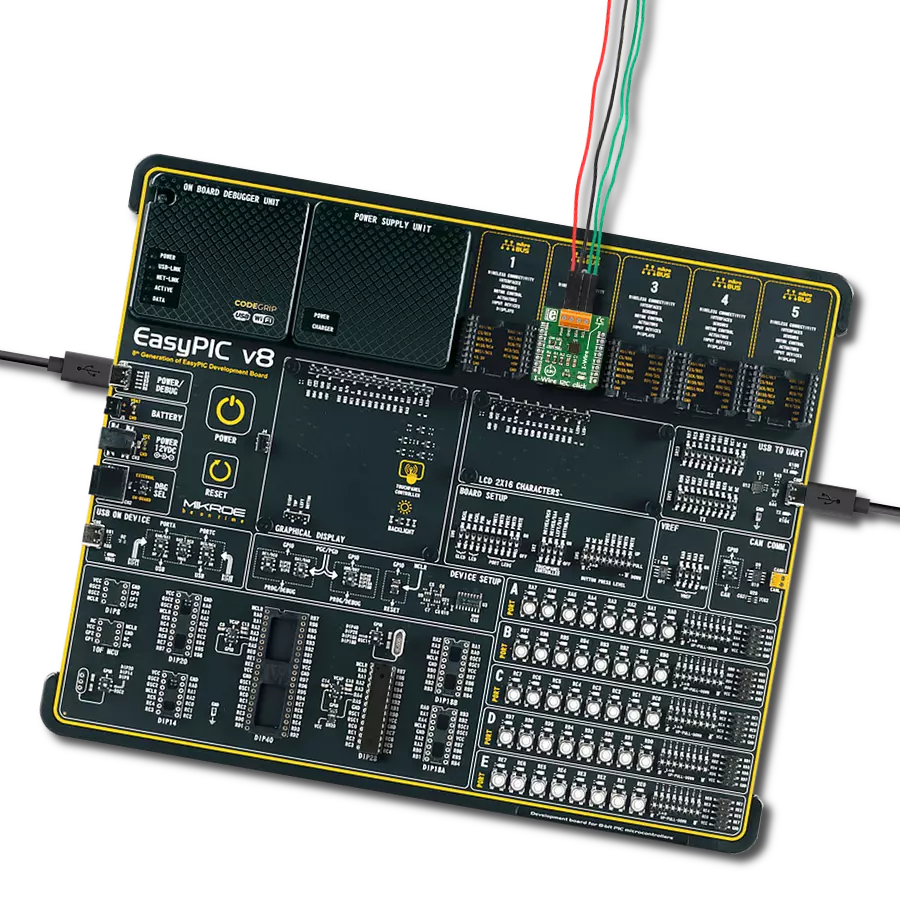创建需要安全物理触点用于数据传输或用户身份识别的系统。
A
A
硬件概览
它是如何工作的?
iButton Click 基于 Demiurge 的 CZ-0-PIN,这是一款高质量的 iButton 探针。金属探针确保抗污垢、灰尘、湿气、震动和其他环境危害,同时确保与 iButton 设备良好对准。制造商保证与 Analog iButton 设备兼容,但该探针可以读取任何与 Maxim iButton 兼容的设备。iButton 设备可以通过数据线利用所谓的寄生电源供电。此 Click 板™ 配备有到 3.3V mikroBUS™ 导轨的上拉电阻,为 iButton 提供电源。iButton 的寄生电源包含一个内部电容
器,一旦数据线充电完毕,该电容器提供足够的电流以确保正常运行。为了使寄生电源正常工作,数据线的空闲状态为高电平,而 iButton 设备的数据线处于开漏配置,当断言时将数据线拉至低逻辑电平。单线通信线被路由到 SMD 跳线,允许将单线通信路由到 mikroBUS™ 的 PWM 引脚或 AN 引脚。这些引脚分别标记为 GP0 和 GP1,与 SMD 跳线位置相同,使所需引脚的选择简单明了。标记为 ST1 的绿色 LED 路由到 mikroBUS™ 的 RST 引脚,而标
记为 ST2 的红色 LED 路由到 mikroBUS™ 的 CS 引脚。这两个引脚允许从软件进行视觉反馈;例如,如果停靠的 iButton 的序列号符合授权标准,绿色 LED 可以发出信号。这些 LED 可以用于任何信号化,并且不直接连接到 iButton 设备。此 Click 板™ 只能在 3.3V 逻辑电压电平下运行。在使用不同逻辑电平的 MCU 之前,必须进行适当的逻辑电压电平转换。此外,它配备了一个包含函数和示例代码的库,可用于进一步开发。
功能概述
开发板
PIC18F57Q43 Curiosity Nano 评估套件是一款尖端的硬件平台,旨在评估 PIC18-Q43 系列内的微控制器。其设计的核心是包含了功能强大的 PIC18F57Q43 微控制器(MCU),提供先进的功能和稳健的性能。这个评估套件的关键特点包括一个黄 色用户 LED 和一个响应灵敏的机械用户开关,提供无
缝的交互和测试。为一个 32.768kHz 水晶振荡器足迹提供支持,确保精准的定时能力。套件内置的调试器拥有一个绿色电源和状态 LED,使编程和调试变得直观高效。此外,增强其实用性的还有虚拟串行端口 (CDC)和一个调试 GPIO 通道(DGI GPIO),提供广泛的连接选项。该套件通过 USB 供电,拥有由
MIC5353 LDO 调节器提供支持的可调目标电压功能,确保在 1.8V 至 5.1V 的输出电压范围内稳定运行,最大输出电流为 500mA,受环境温度和电压限制。
微控制器概述
MCU卡片 / MCU

建筑
PIC
MCU 内存 (KB)
128
硅供应商
Microchip
引脚数
48
RAM (字节)
8196
你完善了我!
配件
Curiosity Nano Base for Click boards 是一款多功能硬件扩展平台,专为简化 Curiosity Nano 套件与扩展板之间的集成而设计,特别针对符合 mikroBUS™ 标准的 Click 板和 Xplained Pro 扩展板。这款创新的基板(屏蔽板)提供了无缝的连接和扩展可能性,简化了实验和开发过程。主要特点包括从 Curiosity Nano 套件提供 USB 电源兼容性,以及为增强灵活性而提供的另一种外部电源输入选项。板载锂离子/锂聚合物充电器和管理电路确保电池供电应用的平稳运行,简化了使用和管理。此外,基板内置了一个固定的 3.3V 电源供应单元,专用于目标和 mikroBUS™ 电源轨,以及一个固定的 5.0V 升压转换器,专供 mikroBUS™ 插座的 5V 电源轨,为各种连接设备提供稳定的电力供应。
DS1990A 是一种独特的序列号识别 iButton™。iButton 技术基于单线通信协议,芯片封装在坚固的不锈钢外壳中。这个按钮形状的设备有两个接触点——盖子和底座。这些接触点将必要的连接传输到嵌入金属按钮内的敏感硅芯片。当 iButton 接触读卡器探针时,通过单线接口与主 MCU 建立通信。通信几乎是瞬间完成的,因此轻轻按下 iButton 使其接触探针即可完成通信。
使用的MCU引脚
mikroBUS™映射器
“仔细看看!”
Click board™ 原理图

一步一步来
项目组装
软件支持
库描述
此库包含用于 iButton Click 驱动的 API。
关键功能:
ibutton_add_key- 该功能从 DS1990A 序列号 iButton 读取 ROM 地址,并将其存储在 ctx->key_rom 缓冲区中ibutton_remove_keys- 该功能通过清除 ctx->key_rom 缓冲区来移除所有存储的钥匙ibutton_check_key- 该功能从 DS1990A 序列号 iButton 读取 ROM 地址,并检查它是否已存储在 ctx->key_rom 缓冲区中
开源
代码示例
完整的应用程序代码和一个现成的项目可以通过NECTO Studio包管理器直接安装到NECTO Studio。 应用程序代码也可以在MIKROE的GitHub账户中找到。
/*!
* @file main.c
* @brief iButton Click Example.
*
* # Description
* This example demonstrates the use of the iButton Click boards by registering a DS1990A Serial Number iButton
* key and then waiting until a key is detected on the reader and identifying if the key matches one of
* those stored in RAM.
*
* The demo application is composed of two sections :
*
* ## Application Init
* Initializes the driver and registers a new DS1990A Serial Number iButton key and stores it in RAM.
*
* ## Application Task
* Waits until a key is detected on the reader, and checks if there's a key found in the library that matches
* the one it has just read. All data is being logged on the USB UART where you can track the program flow.
*
* @author Stefan Filipovic
*
*/
#include "board.h"
#include "log.h"
#include "ibutton.h"
#define NUMBER_OF_KEYS 1 // Number of keys to register.
static ibutton_t ibutton;
static log_t logger;
/**
* @brief iButton led indication function.
* @details This function indicates the selected state over LEDs indication.
* @param[in] ctx : Click context object.
* See #ibutton_t object definition for detailed explanation.
* @param[in] state : @li @c 0 - Disable LEDs.
* @li @c 1 - Wait for a key.
* @li @c 2 - Operation successfull.
* @li @c 3 - Wrong key found.
* @return None.
* @note None.
*/
static void ibutton_led_indication ( ibutton_t *ctx, ibutton_led_state_t state );
/**
* @brief iButton register keys function.
* @details This function registers a desired number of keys.
* Each step will be logged on the USB UART where you can track the function flow.
* @param[in] ctx : Click context object.
* See #ibutton_t object definition for detailed explanation.
* @param[in] num_keys : Number of keys to register.
* @return None.
* @note None.
*/
static void ibutton_register_keys ( ibutton_t *ctx, uint8_t num_keys );
void application_init ( void )
{
log_cfg_t log_cfg; /**< Logger config object. */
ibutton_cfg_t ibutton_cfg; /**< Click config object. */
/**
* Logger initialization.
* Default baud rate: 115200
* Default log level: LOG_LEVEL_DEBUG
* @note If USB_UART_RX and USB_UART_TX
* are defined as HAL_PIN_NC, you will
* need to define them manually for log to work.
* See @b LOG_MAP_USB_UART macro definition for detailed explanation.
*/
LOG_MAP_USB_UART( log_cfg );
log_init( &logger, &log_cfg );
log_info( &logger, " Application Init " );
// Click initialization.
ibutton_cfg_setup( &ibutton_cfg );
IBUTTON_MAP_MIKROBUS( ibutton_cfg, MIKROBUS_1 );
if ( ONE_WIRE_ERROR == ibutton_init( &ibutton, &ibutton_cfg ) )
{
log_error( &logger, " Communication init." );
for ( ; ; );
}
ibutton_register_keys ( &ibutton, NUMBER_OF_KEYS );
log_info( &logger, " Application Task " );
}
void application_task ( void )
{
err_t error_flag = IBUTTON_OK;
ibutton_led_indication ( &ibutton, IBUTTON_LED_DISABLE );
log_printf( &logger, " >>> Waiting for a key <<<\r\n" );
do
{
ibutton_led_indication ( &ibutton, IBUTTON_LED_WAIT_KEY );
error_flag = ibutton_check_key ( &ibutton );
}
while ( IBUTTON_ERROR == error_flag );
ibutton_led_indication ( &ibutton, IBUTTON_LED_DISABLE );
if ( IBUTTON_OK == error_flag )
{
log_printf( &logger, " MATCH, access allowed!\r\n" );
ibutton_led_indication ( &ibutton, IBUTTON_LED_SUCCESS );
}
else if ( IBUTTON_KEY_NO_MATCH == error_flag )
{
log_printf( &logger, " NO MATCH, access denied!\r\n" );
ibutton_led_indication ( &ibutton, IBUTTON_LED_WRONG_KEY );
}
ibutton_led_indication ( &ibutton, IBUTTON_LED_DISABLE );
log_printf( &logger, "--------------------------------\r\n\n" );
Delay_ms ( 500 );
}
int main ( void )
{
/* Do not remove this line or clock might not be set correctly. */
#ifdef PREINIT_SUPPORTED
preinit();
#endif
application_init( );
for ( ; ; )
{
application_task( );
}
return 0;
}
static void ibutton_led_indication ( ibutton_t *ctx, ibutton_led_state_t state )
{
switch ( state )
{
case IBUTTON_LED_DISABLE:
{
ibutton_disable_green_led ( ctx );
ibutton_disable_red_led ( ctx );
break;
}
case IBUTTON_LED_WAIT_KEY:
{
ibutton_enable_green_led ( &ibutton );
Delay_ms ( 250 );
ibutton_disable_green_led ( &ibutton );
ibutton_enable_red_led ( &ibutton );
Delay_ms ( 250 );
ibutton_disable_red_led ( &ibutton );
break;
}
case IBUTTON_LED_SUCCESS:
{
ibutton_enable_green_led ( &ibutton );
Delay_ms ( 250 );
ibutton_disable_green_led ( &ibutton );
Delay_ms ( 250 );
ibutton_enable_green_led ( &ibutton );
Delay_ms ( 250 );
ibutton_disable_green_led ( &ibutton );
Delay_ms ( 250 );
break;
}
case IBUTTON_LED_WRONG_KEY:
{
ibutton_enable_red_led ( &ibutton );
Delay_ms ( 250 );
ibutton_disable_red_led ( &ibutton );
Delay_ms ( 250 );
ibutton_enable_red_led ( &ibutton );
Delay_ms ( 250 );
ibutton_disable_red_led ( &ibutton );
Delay_ms ( 250 );
break;
}
default:
{
break;
}
}
}
static void ibutton_register_keys ( ibutton_t *ctx, uint8_t num_keys )
{
err_t error_flag = IBUTTON_OK;
uint8_t key_cnt = 1;
while ( key_cnt <= num_keys )
{
ibutton_led_indication ( &ibutton, IBUTTON_LED_DISABLE );
log_printf( &logger, " >>> Registering key %u of %u <<<\r\n", ( uint16_t ) key_cnt, ( uint16_t ) num_keys );
log_printf( &logger, " Insert a DS1990A Serial Number iButton to Click board reader plate\r\n" );
do
{
ibutton_led_indication ( &ibutton, IBUTTON_LED_WAIT_KEY );
error_flag = ibutton_add_key ( &ibutton );
}
while ( IBUTTON_ERROR == error_flag );
ibutton_led_indication ( &ibutton, IBUTTON_LED_DISABLE );
if ( IBUTTON_KEY_ALREADY_EXIST == error_flag )
{
log_printf( &logger, " This key is already registered!\r\n" );
log_printf( &logger, " Use another key or decrease the number of keys\r\n" );
ibutton_led_indication ( &ibutton, IBUTTON_LED_WRONG_KEY );
}
else if ( IBUTTON_OK == error_flag )
{
log_printf( &logger, " The key is registered successfully!\r\n" );
ibutton_led_indication ( &ibutton, IBUTTON_LED_SUCCESS );
key_cnt++;
}
ibutton_led_indication ( &ibutton, IBUTTON_LED_DISABLE );
log_printf( &logger, "--------------------------------\r\n\n" );
Delay_ms ( 500 );
}
}
// ------------------------------------------------------------------------ END
额外支持
资源
类别:单线



































